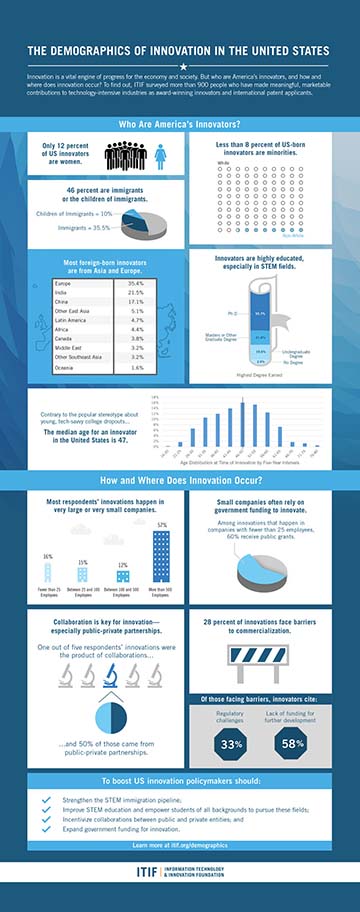
The survey authors summarized some of the main findings in an online infographic. [Image: ITIF] [Enlarge image]
From Edwin Land’s early efforts in the 1920s (see “Broadway Lights Inspire Innovation,” OPN, February 2016) to the very high-profile examples of Bill Gates and Steve Jobs, the story of young college dropouts who go on to change the world through innovation has shown perennial popularity. But a new, broad demographic study of U.S. innovators, echoing some previous results, puts a very different face on today’s typical innovator.
According to the study—from the Information Technology and Innovation Foundation (ITIF), a Washington, D.C.-based think tank—innovators in the United States are disproportionately likely to be middle-aged, Ph.D.-holding males, a large share of them immigrants or non-U.S. citizens. And, in a finding with potentially significant policy implications, females and U.S.-born minorities, especially African-Americans, are dramatically underrepresented among the ranks of top innovators.
Finding “high-value” innovators
The study findings rest on a large survey of people responsible for “high-value innovations”—meaningful and marketable inventions that have had significant commercial impact or potential—between 2011 and 2015. To get at those innovations, the researchers behind the study tapped two main groups of sources. One was the list of persons cited for “groundbreaking innovations” in R&D Magazine’s annual “R&D 100” awards—described by the study authors as “comparable to the Oscars in the film industry.”
The other was the rolls of so-called triadic patents—patent applications in four areas (life sciences, materials science, I.T. and large tech) that have been filed simultaneously in the U.S., Europe, and Japan. The logic behind using triadic patents, according to the ITIF researchers, is that because the process of filing in all three jurisdictions is substantially more labor-intensive than just filing in one area, focusing on triadic patents will tend to select for the most valuable innovations with the highest potential for commercialization.
Trolling through these two groups of sources provided the ITIF researchers with a list of some 9,575 innovators, of whom they could dredge up e-mails for 6,418. They sent this last group a 27-question survey, and obtained “viable responses” from 923, for a response rate of 14 percent—low, but respectable for this kind of study, and sufficient for statistical analysis.
Some surprising (and not-so-surprising) results
Among the ITIF survey's findings:
The value of education and experience. Far from the cliché of the visionary, driven college dropouts, the innovators behind high-value inventions tend to be experienced and highly educated. Some 55 percent have a Ph.D. in a science, technology, engineering or math (STEM) subject. And the median age of the top innovators studied? 47 years old.
Big innovation at big firms. The survey results also challenge the stereotype of the most consequential innovation happening at scrappy start-up companies, with lumbering behemoth firms left in the dust. Some 60 percent of private-sector innovations, according to the survey, happen at firms with more than 500 employees, and only 16 percent at firms with less than 25 workers.
A big role for immigrants. In a U.S. election year when immigration policy has emerged as a persistent and divisive political theme, the survey suggests a huge role for immigrants and non-U.S. citizens in U.S. innovation. A full 35.5 percent of the innovators in the survey were born outside of the United States, and more than 17 percent of innovators “are not U.S. citizens, yet they are making invaluable contributions to U.S. innovation.”
A “striking” gender gap. According to the survey, women represent only 12 percent of U.S. innovators, a far smaller share than the proportion of women obtaining STEM degrees.
Minorities underrepresented. The survey also found substantial underrepresentation among U.S.-born non-white minority groups, including Asians, African Americans, Hispanics, Native Americans, and other groups. In total, these groups constitute some 32 percent of the U.S.-born population—yet they make up just 8 percent of U.S.-born innovators. Particularly sobering is the underrepresentation of African Americans, who constitute only 0.5 percent of U.S.-born innovators, despite representing 13 percent of the U.S.-born population.
A few policy prescriptions
The last two results in particular suggest some specific policy imperatives to the authors of the report. One, they say, is “to do a better job of enabling women and minorities to get STEM degrees.” They suggest expanding the population of so-called STEM high schools, especially in disadvantaged communities, as well as putting mechanisms in place to keep the educational momentum going through college and into doctoral work.
Pointing to “the importance of foreign-born STEM workers to American innovation success,” the study authors also suggest expanding the immigration pipeline, and easing the path for foreign STEM graduates of U.S. universities—who “often have a hard time staying legally”—to remain at work in the United States. “Government has a real role to play,” the study concludes, “in both conducting research and fostering innovation.”
The study can be found at https://itif.org/publications/2016/02/24/demographics-innovation-united-states .
